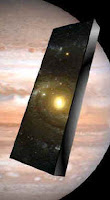 A 14-minute trailer called "Corn, Wine and Oil," an excerpt from a 3-hour film, touches on, in no particular order, the architecture of Washington, DC, Skull and Bones, the hidden meaning of "corn," Masonic cornerstone ceremonies, Baal worship, the Morgan Affair, Royal Arch ritual, George Washington and Benjamin Franklin, and much more. Using spooky music and gee-whiz narration along with interviews with Masonic authors, Christian ministers, Scottish Rite spokesman Brent Morris, and others, the film concludes that Freemasons are creepy Satan worshipers. One interesting clip shows author and Co-Masonry member Dr. Robert Heironimus trashing Skull and Bones as "the most powerful and one of the darkest of all secret societies." There's even a clip of Pres. George W. Bush saying "it's so secret I can't talk about it."
A 14-minute trailer called "Corn, Wine and Oil," an excerpt from a 3-hour film, touches on, in no particular order, the architecture of Washington, DC, Skull and Bones, the hidden meaning of "corn," Masonic cornerstone ceremonies, Baal worship, the Morgan Affair, Royal Arch ritual, George Washington and Benjamin Franklin, and much more. Using spooky music and gee-whiz narration along with interviews with Masonic authors, Christian ministers, Scottish Rite spokesman Brent Morris, and others, the film concludes that Freemasons are creepy Satan worshipers. One interesting clip shows author and Co-Masonry member Dr. Robert Heironimus trashing Skull and Bones as "the most powerful and one of the darkest of all secret societies." There's even a clip of Pres. George W. Bush saying "it's so secret I can't talk about it."Here's the movie's blurb, from Google Video:
New 14 Minute Trailer — "Riddles In Stone: Secret Architecture of Washington, D.C.," will continue to explore the fascinating history behind the origins and focus of the world's most powerful nation: America. Why was this nation founded? How was the precise location of Washington, D.C., determined? What is the meaning of the seemingly countless occult images in our nation's capitol?Watch the video at Google Video or below.
Volume II zeroes in on the Masonic & Rosicrucian influence so prevalent amongst our Founding Fathers as they planned, and began to implement, the layout of America's Capitol. For years, extreme controversy has abounded as to the exact meaning of the occult symbols found within the street layout, the buildings, and the monuments of Washington, D.C.
Is there really an inverted Pentagram formed by the street layout just north of the White House? We have discovered the esoteric reason why this Pentagram is missing one segment.
Was this city laid out to reflect the vision of a Masonic Christ foreseen by Sir Francis Bacon? Is it true that America's capitol was laid out "according to the stars", i.e., in the astrological shapes of certain planets and stars so revered by occultists?
Why did our Masonic Founding Fathers perform "Corn, Wine, and Oil" ceremonies at cornerstone layings and at the dedication of the finished structure?
Does this occult "wisdom" represent the interests of America, or a hidden agenda?
As with Volume I, this "Secret Mysteries" series will continue to explore current — and possibly future — events by examining America's past. What can these realities mean for the unfolding destiny of America and the world? Now you will know that, when President Bush said he was fulfilling the "Ancient Hope" of the "New Order of the Ages" (as we show in Volume I), he was merely acting out the plan reflected in the street layout and in the architecture of Washington, D.C.
Masons | Masonic Ritual | Anti-Mason | Freemasonry | Burning Taper | BurningTaper.com


























